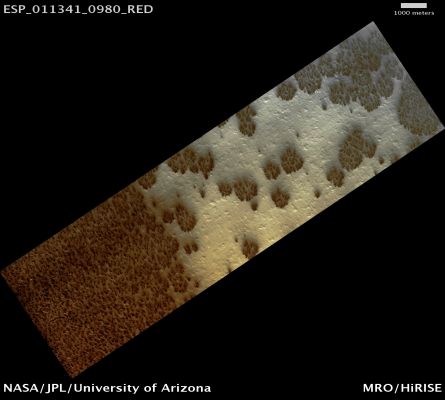|
|
Starburst Fans, or: the Arthur Clarke Trees (Natural Colors; credits: Lunar Explorer Italia)
|
Quante volte, su Siti (fanta/pseudo) Scientifici avete visto e letto degli "Alberi Marziani" (che sono anche - e meglio - noti al Pubblico come "Arthur Clarke Trees", in omaggio al Creatore della Saga di "2001 - Odissea nello Spazio")?
Sicuramente tante volte.
Oggi (in realtà esistevano già altre riprese sufficientemente chiare, ma facciamo finta che non lo fossero...), grazie a questa splendida immagine ottenuta dalla Sonda MRO, il "mistero" degli Alberi Marziani possiamo dire che è definitivamente risolto (anche se, a nostro avviso, queste Surface Features non erano mai state un VERO mistero): si tratta di Fans a forma di "stella che esplode".
E come si sono generati questi Fans (---sbuffi)? Ce lo spiega la NASA stessa:"During the Martian Winter a layer of Carbon Dioxide Ice (CO2, or Dry Ice) forms a seasonal cap over the South Polar Region. In the Spring — when the Sun starts to warm the ice and the surface below — gas escapes from beneath the ice layer, carrying dust with it.
The dust is deposited on top of the ice in Fans, with an orientation determined by the prevailing wind direction. In this Region, the gas flows along radial channels, so that when it emerges we see a circular set of Dust Fans. These inspire the “starburst” description".
La "morale" è sempre la stessa: i Misteri - su Marte e nel resto di Sistema Solare e del Cosmo - ci sono, esistono e sono grandi ed affascinanti.
Non serve quindi "inventarne" di sana pianta (se non per consentire a qualcuno di mettersi soldi e facile notorietà in tasca): basta osservare, studiare ed infine - credeteci - di motivi per sognare e per comprendere che "non siamo soli", ne troverete a milioni.
"Piramidi", "Sfingi" e "Parabole"? NO, grazie!
Mars Local Time: 17:06 (middle afternoon)
Coord. (centered): 81,8° South Lat. and 76,1° East Long.
Spacecraft altitude: 246,9 Km (such as about 154,3 miles)
Original image scale range: 49,4 cm/pixel (with 1 x 1 binning) so objects ~1,48 mt across are resolved
Map projected scale: 50 cm/pixel
Map projection: EQUIRECTANGULAR
Emission Angle: 0,2°
Phase Angle: 88,0°
Solar Incidence Angle: 88° (meaning that the Sun is about 2° above the Local Horizon)
Solar Longitude: 180,8° (Northern Autumn)
Credits: NASA/JPL/University of Arizona
Additional process. and coloring: Lunar Explorer Italia
|
|










 (Mostra dettagli)
(Mostra dettagli)





